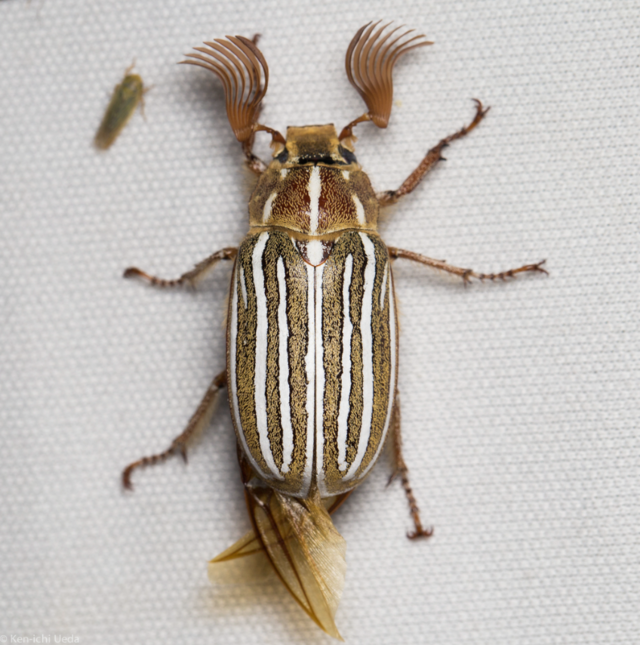Polyphylla decemlineata, commonly known as the Ten-Lined June Beetle or Watermelon Beetle, is a large, distinctive beetle from the Scarabaeidae family. It is native to North America, particularly in the western United States and parts of Canada. This species is well known for its striking white-striped elytra, large lamellate antennae, and its characteristic hissing sound when disturbed.
As an important species in entomology, Polyphylla decemlineata has been widely studied due to its impact on agriculture, its nocturnal behaviors, and its unique life cycle. This article will provide a comprehensive overview of its morphology, habitat, diet, reproductive cycle, and its ecological and economic significance.
Kingdom: Animalia
Phylum: Arthropoda
Class: Insecta
Order: Coleoptera
Family: Scarabaeidae
Subfamily: Melolonthinae
Genus: Polyphylla
Species: Polyphylla decemlineata

Polyphylla decemlineata is one of the largest June beetles in North America, with adult sizes ranging from 25 to 40 millimeters (1 to 1.5 inches). Its defining physical traits include:
Distinct Striped Elytra: The elytra (hardened forewings) display ten parallel white stripes against a brownish or black background, giving it the name "Ten-Lined June Beetle."
Large Lamellate Antennae: Males have prominent fan-like antennae, composed of multiple leaf-like segments that help detect pheromones released by females.
Hissing Defense Mechanism: When threatened, the beetle produces a hissing sound by expelling air through small openings (spiracles) on its abdomen. This startles predators and is a unique feature among beetles.
Sexual Dimorphism: Males are distinguished by their larger, more elaborate antennae, while females have smaller, more compact ones.
Polyphylla decemlineata is found across various regions of North America, with a primary concentration in western states such as California, Arizona, Nevada, Oregon, and British Columbia.
Sandy and Loose Soils: These beetles prefer sandy environments, particularly near pine forests, grasslands, and desert margins.
Agricultural Areas: They can also be found near crop fields, as their larvae feed on roots of various plants, making them an agricultural concern.
Urban and Suburban Areas: Adult beetles are often attracted to porch lights at night, leading to frequent encounters with humans.
The feeding habits of Polyphylla decemlineata differ between the larval and adult stages.
Feed primarily on roots of grasses, trees, and crops such as corn, strawberries, and turfgrass.
Can cause significant damage to agricultural crops by weakening or killing plants due to root destruction.
The larval stage can last up to four years, leading to prolonged feeding damage in affected areas.
Adults primarily feed on tree leaves, particularly those from pine, oak, and fruit trees.
Unlike larvae, adults cause minimal feeding damage and primarily serve as reproductive agents before dying after a few weeks.
Polyphylla decemlineata follows a multi-year life cycle, which consists of the following stages:
Female beetles lay eggs in sandy or loose soil after mating.
Each female lays 30 to 80 eggs, which hatch in 2-3 weeks.
The grubs develop underground, feeding on plant roots for multiple years.
This stage is the most damaging to agriculture, as root consumption weakens or kills host plants.
Mature larvae burrow deeper into the soil and enter the pupal stage, where they undergo metamorphosis.
This stage lasts several weeks, preparing the beetle for adulthood.
Adult beetles emerge during summer months (June-August).
They are nocturnal, often seen flying toward lights at night.
Adults primarily focus on mating and reproduction, after which they die.
Nocturnal Activity: Polyphylla decemlineata is most active at night, using its antennae to detect potential mates.
Phototaxis (Light Attraction): Adult beetles are strongly drawn to artificial lights, often appearing around homes and streetlights during summer.
Defensive Hissing: When threatened, it emits a hissing sound, which serves as a deterrent to predators such as birds, rodents, and amphibians.
Strong Mandibles: Though not aggressive, adult beetles can pinch with their mandibles when handled, though they are generally harmless to humans.
Polyphylla decemlineata contributes to nutrient recycling by breaking down organic material in the soil.
Its larvae serve as an important food source for birds, mammals, and reptiles.
Root Damage: Larvae feed on the roots of crops, trees, and grasses, causing wilting, yellowing, and eventual plant death.
Economic Loss: Farmers often report yield reductions in corn, turfgrass, strawberries, and ornamental plants due to larval feeding.
Control Methods:
Biological Control: Predators such as nematodes and fungi help regulate larval populations.
Chemical Control: Insecticides targeting grubs are used in severe infestations.
Cultural Control: Rotating crops and maintaining healthy soil can minimize beetle outbreaks.
Despite its impact on agriculture, Polyphylla decemlineata is not considered endangered. It remains a common species in North America, with stable populations.
Often mistaken for dangerous insects, though it is harmless to humans.
Frequently found near porch lights, leading to curiosity and occasional annoyance among homeowners.
Some entomologists and collectors admire its unique appearance, making it a sought-after species for scientific study and insect collections.
Polyphylla decemlineata, the Ten-Lined June Beetle, is a fascinating species known for its distinct striped pattern, nocturnal behavior, and large antennae. While it plays an essential role in ecosystems, its larvae pose significant threats to agriculture, making it an important species to monitor.
Understanding its habitat, life cycle, and ecological role can help in developing sustainable management strategies to balance its presence in nature while protecting valuable crops.
animal tags: Scarabaeidae
We created this article in conjunction with AI technology, then made sure it was fact-checked and edited by a Animals Top editor.